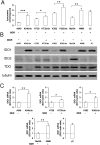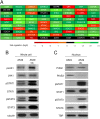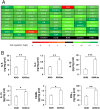An Autocrine Cytokine/JAK/STAT-Signaling Induces Kynurenine Synthesis in Multidrug Resistant Human Cancer Cells
- PMID: 25955018
- PMCID: PMC4425697
- DOI: 10.1371/journal.pone.0126159
An Autocrine Cytokine/JAK/STAT-Signaling Induces Kynurenine Synthesis in Multidrug Resistant Human Cancer Cells
Abstract
Background: Multidrug resistant cancer cells are hard to eradicate for the inefficacy of conventional anticancer drugs. Besides escaping the cytotoxic effects of chemotherapy, they also bypass the pro-immunogenic effects induced by anticancer drugs: indeed they are not well recognized by host dendritic cells and do not elicit a durable anti-tumor immunity. It has not yet been investigated whether multidrug resistant cells have a different ability to induce immunosuppression than chemosensitive ones. We addressed this issue in human and murine chemosensitive and multidrug resistant cancer cells.
Results: We found that the activity and expression of indoleamine 2,3-dioxygenase 1 (IDO1), which catalyzes the conversion of tryptophan into the immunosuppressive metabolite kynurenine, was higher in all the multidrug resistant cells analyzed and that IDO1 inhibition reduced the growth of drug-resistant tumors in immunocompetent animals. In chemoresistant cells the basal activity of JAK1/STAT1 and JAK1/STAT3 signaling was higher, the STAT3 inhibitor PIAS3 was down-regulated, and the autocrine production of STAT3-target and IDO1-inducers cytokines IL-6, IL-4, IL-1β, IL-13, TNF-α and CD40L, was increased. The disruption of the JAK/STAT signaling lowered the IDO1 activity and reversed the kynurenine-induced pro-immunosuppressive effects, as revealed by the restored proliferation of T-lymphocytes in STAT-silenced chemoresistant cells.
Conclusions: Our work shows that multidrug resistant cells have a stronger immunosuppressive attitude than chemosensitive cells, due to the constitutive activation of the JAK/STAT/IDO1 axis, thus resulting chemo- and immune-evasive. Disrupting this axis may significantly improve the efficacy of chemo-immunotherapy protocols against resistant tumors.
Conflict of interest statement
Figures






Similar articles
-
Salinomycin promotes T-cell proliferation by inhibiting the expression and enzymatic activity of immunosuppressive indoleamine-2,3-dioxygenase in human breast cancer cells.Toxicol Appl Pharmacol. 2020 Oct 1;404:115203. doi: 10.1016/j.taap.2020.115203. Epub 2020 Aug 19. Toxicol Appl Pharmacol. 2020. PMID: 32822738
-
Stimulation of the JAK/STAT pathway by LIF and OSM in the human granulosa cell line COV434.J Reprod Immunol. 2015 Apr;108:48-55. doi: 10.1016/j.jri.2015.03.002. Epub 2015 Mar 16. J Reprod Immunol. 2015. PMID: 25817464
-
JAK/STAT pathway plays a critical role in the proinflammatory gene expression and apoptosis of RAW264.7 cells induced by trichothecenes as DON and T-2 toxin.Toxicol Sci. 2012 Jun;127(2):412-24. doi: 10.1093/toxsci/kfs106. Epub 2012 Mar 27. Toxicol Sci. 2012. PMID: 22454431
-
The potential of targeting indoleamine 2,3-dioxygenase for cancer treatment.Expert Opin Ther Targets. 2015 May;19(5):605-15. doi: 10.1517/14728222.2014.995092. Epub 2015 Feb 15. Expert Opin Ther Targets. 2015. PMID: 25684107 Review.
-
JAK/STAT pathway directed therapy of T-cell leukemia/lymphoma: Inspired by functional and structural genomics.Mol Cell Endocrinol. 2017 Aug 15;451:66-70. doi: 10.1016/j.mce.2017.02.019. Epub 2017 Feb 15. Mol Cell Endocrinol. 2017. PMID: 28214593 Free PMC article. Review.
Cited by
-
Bidirectional effects of the tryptophan metabolite indole-3-acetaldehyde on colorectal cancer.World J Gastrointest Oncol. 2024 Jun 15;16(6):2697-2715. doi: 10.4251/wjgo.v16.i6.2697. World J Gastrointest Oncol. 2024. PMID: 38994159 Free PMC article.
-
IDO1-mediated kynurenine production inhibits IGFBP5 signaling to promote 5-fluorouracil-induced senescence escape and chemoresistance in colorectal cancer.Am J Cancer Res. 2024 Sep 25;14(9):4551-4566. doi: 10.62347/XTRC3347. eCollection 2024. Am J Cancer Res. 2024. PMID: 39417170 Free PMC article.
-
Signal transducer and activator of transcription (STAT)-5: an opportunity for drug development in oncohematology.Oncogene. 2019 Jun;38(24):4657-4668. doi: 10.1038/s41388-019-0752-3. Epub 2019 Feb 19. Oncogene. 2019. PMID: 30783189 Review.
-
Progress and challenges of multidrug resistance proteins in diseases.Am J Cancer Res. 2022 Oct 15;12(10):4483-4501. eCollection 2022. Am J Cancer Res. 2022. PMID: 36381332 Free PMC article. Review.
-
Chemotherapeutic Resistance Genes of Breast Cancer Patients - An Overview.Adv Pharm Bull. 2022 Aug;12(4):649-657. doi: 10.34172/apb.2022.048. Epub 2021 May 30. Adv Pharm Bull. 2022. PMID: 36415633 Free PMC article. Review.
References
-
- Gottesman MM, Fojo T, Bates SE (2002). Multidrug resistance in cancer: role of ATP-dependent transporters. Nat Rev Cancer 2(1): 48–58. - PubMed
-
- Obeid M, Tesniere A, Ghiringhelli F, Fimia GM, Apetoh L, Perfettini JL, et al. (2007) Calreticulin exposure dictates the immunogenicity of cancer cell death. Nat Med 13(1): 54–61. - PubMed
Publication types
MeSH terms
Substances
Grants and funding
LinkOut - more resources
Full Text Sources
Other Literature Sources
Research Materials
Miscellaneous

